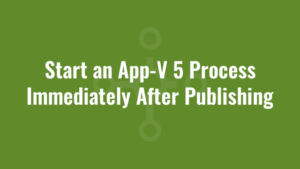I have a piece of software that acts as an ‘agent’ sitting in the background (in the System Tray) waiting to intercept print requests. It needs to be running all the time since it intercepts print requests from ANY desktop application. So this blog posts explains how to start an App-V 5 process immediately after publishing.
Start an App-V 5 Process Immediately After Publishing
The target platforms are a combination of standard desktops and non-persistent VDI desktops. Making it work with standard desktops wasn’t really the problem – by default the software placed a shortcut in the Startup folder and after publishing, logging off and logging in the background process started.
The trouble with a non-persistent VDI is that when a user logs off and logs back in, they get a completely fresh desktop experience and all the apps get published again. As a result of this we can’t just lump some logic in a Run key or the Startup folder since the application is published after these features are processed.
Combined with this there were another 2 applications that needed connection-grouping with this agent application.
Unless there’s a more elegant way of achieving this that I’m not aware of, I present my solution forthwith:
Start an App-V 5 Process Using PublishPackage
Firstly, since we’re publishing to users, I have added a user script at publish time in the AppxManifest.xml file (or you could use the UserConfig.xml file – your choice depending on which version of App-V you’re using):
<appv:UserScripts>
<appv:PublishPackage>
<appv:Path>cmd.exe</appv:Path>
<appv:Arguments>/c START "" "powershell.exe" -ExecutionPolicy ByPass -WindowStyle Hidden -File "[{AppVPackageRoot}]\..\Scripts\runProcess.ps1"</appv:Arguments>
<appv:Wait RollbackOnError="false" />
</appv:PublishPackage>
</appv:UserScripts>
What’s important to note is that we can’t just point at our background process for 2 reasons:
- Because the application is not yet published at this point, and so we can’t access/run it
- Even if we could access/run it, the publishing process would stick at running the .exe since the .exe will always be running and the PublishPackage action will never release the handle (unless we manually kill it). And hence the package would never publish!
Instead we’ve called cmd.exe with the START command. What this does is launch powershell.exe as a separate process and does NOT wait for it to complete. Hence the publishing of the app will complete as normal. Meanwhile in the background, powershell.exe runs a script that I’ve placed in the Scripts folder in the background. So what does the script do? In essence it:
- Loops 10 times maximum, with a 5 second delay between each loop, and attempts to get the package (Get-AppvClientPackage) and ensure it is published to the user (IsPublishedToUser). We cannot run the process if the package is not published.
- Loops 10 times maximum, with a 5 second delay between each loop, and attempts to get the connection group (Get-AppvClientConnectionGroup) and ensure it is enabled (IsEnabledToUser). If using a connection group, we cannot enable a connection group if a package is in use! So we need to wait until the connection group is enabled before we attempt to start the process.
- Loops 10 times maximum, with a 5 second delay between each loop, and attempts to start the process (Start-Process). There’s no reason why it shouldn’t start first time, but I still add in some retries just in case.
Here is the script (this supports Connection Groups – see below if you are not using a connection group)
#variable to store the current script folder (in case, for ease, we want to put our exe's in the same folder as the script)
$ScriptFolder = $PSScriptRoot
#path that points to the 'Root' folder inside an app-v package
$appvRoot = split-path $ScriptFolder -parent
$appvRoot = $appvRoot + "\Root"
#default number of attempts
$attempts = 10
#path to exe inside app-v package
$processPath = "$appvRoot\VFS\ProgramFilesX86\Equitrac\Express\Client\EQMsgClient.exe"
#process name without exe (used with Get-Process)
$processName = "EQMsgClient"
#name of App-V package
$packageName = "Nuance_EquitracExpressClient_5.4.23.4801"
#name of connection group
$connectionGroupName = "Equitrac Express"
#initialise
$packageObject = $false
$connectionGroupObject = $false
$newProcess = $null
$eventMessage = "Attempting to run: " + $processPath
write-host $eventMessage
#wait until package is published
$packageObject = Get-AppvClientPackage -Name $packageName -ErrorAction SilentlyContinue
while (($packageObject -eq $null -Or (!($packageObject.IsPublishedToUser))) -And $attempts -gt 0)
{
Start-Sleep -s 5
$attempts = $attempts - 1
$eventMessage = "Checking if the following package is published: " + $packageName + " (Attempts remaining: " + $attempts + ")"
write-host $eventMessage
$packageObject = Get-AppvClientPackage -Name $packageName -ErrorAction SilentlyContinue
}
if ($packageObject.IsPublishedToUser)
{
$eventMessage = "The following package is published: " + $packageName
write-host $eventMessage
#now we need to check that the connection group has applied and is published!
$connectionGroupObject = Get-AppvClientConnectionGroup -Name $connectionGroupName -ErrorAction SilentlyContinue
#reset attempts
$attempts = 10
while (($connectionGroupObject -eq $null -Or (!($connectionGroupObject.IsEnabledToUser))) -And $attempts -gt 0)
{
Start-Sleep -s 5
$attempts = $attempts - 1
$eventMessage = "Checking if the following connection group is enabled: " + $connectionGroupName + " (Attempts remaining: " + $attempts + ")"
write-host $eventMessage
$connectionGroupObject = Get-AppvClientConnectionGroup -Name $connectionGroupName -ErrorAction SilentlyContinue
}
if ($connectionGroupObject.IsEnabledToUser)
{
$eventMessage = "The following connection group is enabled: " + $connectionGroupName
write-host $eventMessage
#reset attempts
$attempts = 10
#now try and start our process
while (((Get-Process -Name $processName -ErrorAction SilentlyContinue) -eq $null) -And $attempts -gt 0)
{
if (Test-Path $processPath)
{
$newProcess = Start-Process -FilePath $processPath -PassThru -NoNewWindow -ErrorAction SilentlyContinue
}
else
{
$eventMessage = "Process path : " + $processPath + " was not found. Unable to start process."
write-host $eventMessage
break
}
$attempts = $attempts - 1
$eventMessage = "Trying to start process: " + $processPath + " (Attempts remaining: " + $attempts + ")"
write-host $eventMessage
Start-Sleep -s 5
}
if ($newProcess -eq $null)
{
$eventMessage = "Process : " + $processPath + " could not be launched."
write-host $eventMessage
}
else
{
$eventMessage = "Process : " + $processPath + " was launched successfully."
write-host $eventMessage
}
}
else
{
$eventMessage = "Connection Group : " + $connectionGroupName + " was not enabled. Unable to start process."
write-host $eventMessage
}
}
else
{
$eventMessage = "Package : " + $packageName + " was not published. Unable to start process."
write-host $eventMessage
}
Here is the same script (without Connection Group logic)
#now start SAP process
#variable to store the current script folder (in case, for ease, we want to put our exe's in the same folder as the script)
$ScriptFolder = $PSScriptRoot
#path that points to the 'Root' folder inside an app-v package
$appvRoot = split-path $ScriptFolder -parent
$appvRoot = $appvRoot + "\Root"
#default number of attempts
$attempts = 10
#path to exe inside app-v package
$processPath = "$appvRoot\VFS\ProgramFilesX86\SAP\FrontEnd\SecureLogin\bin\sbus.exe"
#process name without exe (used with Get-Process)
$processName = "sbus"
#name of App-V package
$packageName = "W10_SAP_SAPBusinessUser_7.50_V_P1"
#initialise
$packageObject = $false
$newProcess = $null
$eventMessage = "Attempting to run: " + $processPath
write-host $eventMessage
#wait until package is published
$packageObject = Get-AppvClientPackage -Name $packageName -ErrorAction SilentlyContinue
while (($packageObject -eq $null -Or (!($packageObject.IsPublishedToUser))) -And $attempts -gt 0)
{
Start-Sleep -s 5
$attempts = $attempts - 1
$eventMessage = "Checking if the following package is published: " + $packageName + " (Attempts remaining: " + $attempts + ")"
write-host $eventMessage
$packageObject = Get-AppvClientPackage -Name $packageName -ErrorAction SilentlyContinue
}
if ($packageObject.IsPublishedToUser)
{
$eventMessage = "The following package is published: " + $packageName
write-host $eventMessage
#now try and start our process
while (((Get-Process -Name $processName -ErrorAction SilentlyContinue) -eq $null) -And $attempts -gt 0)
{
if (Test-Path $processPath)
{
$newProcess = Start-Process -FilePath $processPath -PassThru -NoNewWindow -ErrorAction SilentlyContinue
}
else
{
$eventMessage = "Process path : " + $processPath + " was not found. Unable to start process."
write-host $eventMessage
break
}
$attempts = $attempts - 1
$eventMessage = "Trying to start process: " + $processPath + " (Attempts remaining: " + $attempts + ")"
write-host $eventMessage
Start-Sleep -s 5
}
write-host $newProcess
if ($newProcess -eq $null)
{
$eventMessage = "Process : " + $processPath + " could not be launched."
write-host $eventMessage
}
else
{
$eventMessage = "Process : " + $processPath + " was launched successfully."
write-host $eventMessage
}
}
else
{
$eventMessage = "Package : " + $packageName + " was not published. Unable to start process."
write-host $eventMessage
}Things to tweak
The variables at the top (package names etc). Also remember this targets packages published to the user, not the machine. So you’ll need to tweak things like ‘isEnabledToUser’ and ‘isPublishedToUser’ etc. Also you may not be using a connection group like me, so you could chop that logic out too.
A note before you commence…
Since the background process is always running, it obviously can’t be unpublished instantly (because the package will be in use). Luckily we’re running the App-V 5 SP2 client which will set up a pending task to un-publish it when the user logs off and back in. You may want to consider this before implementing it.






Thank you for this post; I am trying to do something similar. I am sequencing a version of Mozilla Firefox that needs to launch to create profile in %appdata% and cert file needs to copied here hence the dilemma also in a non persistent VDI. I have the script and everything completed but during publishing the Firefox.exe does not launch. I see two cmd shells launch but nothing after that. Not sure what I am missing .
Hi Prakash. Sorry for the delay – I’ve been a bit busy recently. I hope you resolved this issue. Thanks. Kae.